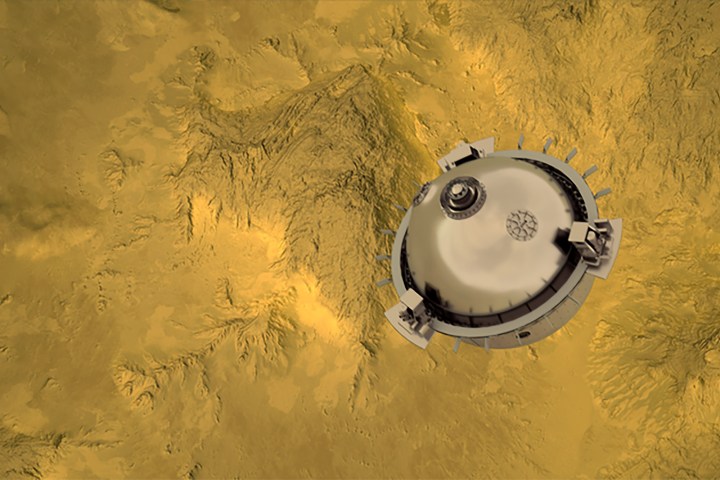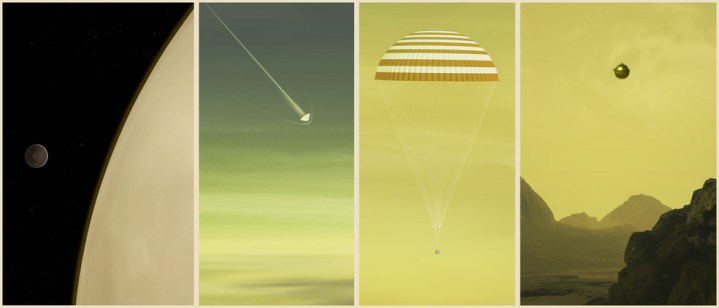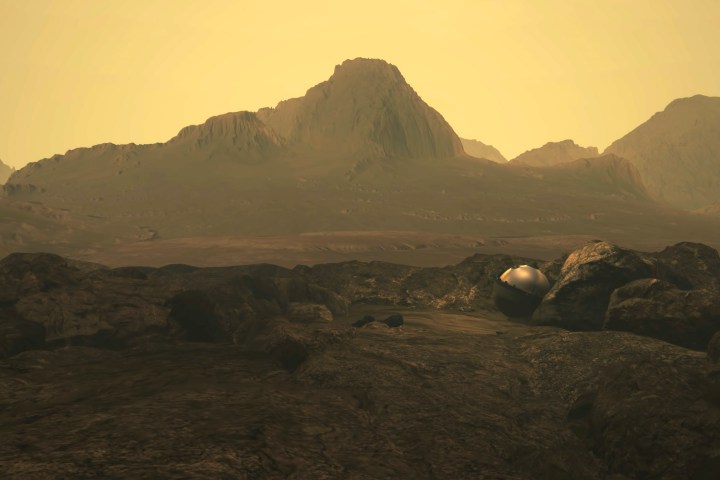As it happens to be our next-door neighbor, you might imagine that we have a thorough understanding of the planet Venus. But you’d be wrong. NASA hasn’t visited the planet in more than 30 years, and there’s so much about the place that we barely understand, from its geological history to what kinds of rocks are on its surface, that much of its environment is essentially a mystery.
Scientists think that Venus was once like Earth, but the two diverged at some point in their evolution to become the vastly different places they are today. We know Venus has a thick atmosphere that keeps in heat and makes it the hottest planet in the solar system. And we know that its surface is covered in mountains, rifts, and volcanoes, though we don’t know if these are still active.
One reason that so much remains unknown about Venus is that its thick atmosphere hides most of its terrain from view, and it’s hard to peer through layers of clouds to see what is beneath. Another reason is that it’s a chillingly inhospitable place. Between its baking temperatures and its thick, acid-filled atmosphere, nothing man-made has survived on its surface for more than a few minutes.
But if we want to know more about this mysterious planet next door, we need to visit it. And that’s just what NASA’s DAVINCI mission plans to do, by dropping a probe through the atmosphere to take readings all the way down as it falls to the surface. The mission, which will be one of a trio of missions to Venus in the next decade, is scheduled to launch in 2029 and to arrive at Venus for its plummet through the atmosphere in 2031.
To find out how you build a probe to withstand this hellish environment, and what we might learn from it, we spoke to two members of the DAVINCI team: Jim Garvin, principal investigator for the mission, and Mike Sekerak, systems project engineer.
What’s up with Venus’ atmosphere?

Venus represents a frontier in planetary science about which very little is known, considering how relatively nearby it is to us. What is happening beneath the upper cloud layer is a particularly intriguing question.
“The characterization of the atmosphere, from the top of the clouds to the surface – this big, massive atmosphere, 75% of the mass of which is in the lower 15 to 20 kilometers – is almost unexplored,” Garvin said.
Probes sent to Venus in the 1960s and 1970s tried to gather data about the atmosphere, and had some success. But previous measurements taken of the atmosphere have been unreliable, because of physical problems with previous probes like clogged inlets and the limited technology available. That led to some scrambled readings, of which Garvin says: “Some of them don’t make sense.”
The lower atmosphere in particular is in many ways a mystery. It could be a supercritical fluid, in which the temperature and pressure is so great that it sloshes around like a liquid. There’s also the question of how the rocks on the planet’s surface interact with the atmosphere.
And studying the atmosphere and surface could help answer one of the biggest questions we have about Venus: Did it once have liquid water oceans on its surface, and if so, what happened to them?
Two big challenges

Venus is not a welcoming place for a probe: It’s twice as hot as an oven and there is more pressure on the surface than being under a kilometer of ocean.
“The technical challenges we have here are pretty exciting,” Sekerak said. The biggest issue for any potential mission to Venus is the heat, as the surface temperatures can be as high as 900 degrees Fahrenheit (475 degrees Celsius). That’s hot enough to melt lead, and it wreaks havoc with electronics.
That’s only one part of the environmental challenge though. “The pressure, however, is not far behind in terms of difficulties,” Sekerak said. The pressure at the surface is around 95 bars, or nearly 100 times the atmospheric pressure on Earth’s surface, so engineering a probe for this kind of environment is kind of like building a submarine.
When it is dropped into the atmosphere, DAVINCI will be in a race against time to gather all the information it needs before the heat and pressure destroy its components. To keep the probe active for as long as possible, it is spherical and covered in a thick titanium shell to withstand the pressure and insulate against the heat. Then there’s more insulation inside this shell, made of special materials including astroquartz, a type of fiber made from fused quartz.
The interior is designed to keep components thermally isolated from the exterior as well, to prevent heat from being transferred from the shell. It’s then filled with carbon dioxide gas to protect the high-voltage electronics from sparking and to stop any Earth gases from leaking in during launch.
Overall, the probe, which the team calls the descent sphere, is about one meter across. It will be released from an orbiter with a parachute to slow its descent, though the atmosphere helps with this because it’s so thick that it’s more like dropping the probe through water than through air.
In total, it will take 63 minutes for the probe to reach the surface, and in that one hour it will gather as much data as it possibly can before it is inevitably destroyed by the brutal environment.
Sampling all the way down

The descent sphere will be falling through the atmosphere and sampling all the way down, to build up a picture of the atmosphere from the top to the bottom.
Inside the sphere will be instruments like spectrometers, similar to the instruments on the Mars rovers Curiosity and Perseverance, which can measure the chemical composition of samples by looking at the wavelengths of light that they absorb. But unlike the Mars rovers, which can take hours or days to collect and carefully analyze a sample, DAVINCI will have to do its sampling and analysis in a matter of minutes.
There are inlet valves at various points over the sphere, with ceramic covers that break off to ingest gases. These gases have to be analyzed extremely quickly, then vented so that more samples can be taken. This will allow the probe to get the most detailed look yet at the chemistry of the atmosphere throughout all of its layers.
While this is happening, other sensors in the probe will be measuring factors like temperature and pressure, to help understand the structure of the atmosphere. Then all this data will be sent back to the orbiter before the probe hits the surface.
The probe is only designed to sample to atmosphere, and not to land. But when it does touch down on the surface, there’s a possibility that it will survive. The thick atmosphere and parachute will help slow its descent, but, “it will definitely hit at a velocity that is, uhh, less than ideal for spaceflight hardware,” Sekerak said with a laugh.
If the probe does survive the landing, though, it might last up to 20 minutes of collecting data before the heat soaks through the sphere and fries the electronics. And that will be even more bonus data on the surface temperature and pressure, as well as the gases present.
Understanding the chemistry of the atmosphere is only one part of DAVINCI’s goals. The other part, which might be most exciting to the public, is taking photos of the mysterious Venusian surface.
Venus at a human scale

The probe will be coming down “in the mountains of Venus, in a kind of terrain that’s never been seen by humanity before,” Garvin said. And the team wants to record this experience visually as well as chemically.
The descent sphere will also have a camera that will be snapping high-contrast images of the surface, which can then be built up into 3D maps.
For a camera to operate from inside a metal sphere, though, you need a window. And glass isn’t a great material for dealing with intensely high-pressure environments. That’s why DAVINCI’s window will be made not of glass but sapphire.
“It literally is a very, very big piece of sapphire,” Sekerak said. “Because it has great optical properties.” It is very strong but also very clear, so it won’t distort images taken through it. But inevitably, a window that lets in light will also let in more heat, so the engineers added phase change materials around the window assembly. This material melts at a specific temperature to absorb the excess heat from the window.
This will allow the camera to take clear, sharp images during its descent. These will be used to photograph the terrain of Venus, from high up and all the way down to the surface itself.
“Our final images will have 10-centimeter resolution,” Garvin said. “That’s the scale you’d see looking out across your living room.”
As well as offering a wealth of scientific data, Garvin hopes that capturing images at this scale will help the public feel like they can see Venus as a real place, not merely a dot to be observed from afar.
“We want to bring human vision and our sensory perception to Venus,” he said. “We’ll start to sense Venus at the human scale.”
Testing for the unknown
The real tricky part of a mission to Venus isn’t even dealing with the challenges we know about, like the temperature and the pressure. It’s trying to anticipate what challenges might arise from an environment that we have so little information about.
That’s why testing and preparation will be a big part of what the DAVINCI team does for the next seven years, in preparation for a launch scheduled for 2029.
“We do worst-case testing,” Sekerak explained. “So we test what the worst environment could possibly be.”
For example, researchers know that the clouds of Venus have drops of sulfuric acid in them – and sulfuric acid eats through materials. It’s a particular concern for the Kevlar lanyard that will attach the descent sphere to the parachute. So to test whether the lanyard can withstand the acidic environment, the engineers don’t just suspend it in a few drops of acid – they coat the entire surface in acid, then test the lanyard’s pull strength to make sure it can survive long enough to take the probe through the atmosphere even in the worst possible case.
As for how you test hardware in environments so unlike Earth, you have to get creative. To see how long it would take for the metal sphere to heat up, the team took it to a metal foundry. “Their job is to melt down metal,” Sekerak said. “And we put our instrumentation inside there to practice getting it hot, to measure that heat flow.”
The idea is to build enough margin into every critical system to allow for whatever unknowns the planet might throw at the sphere. Garvin explained: “We’ve built … a lot of engineering thought and risk reduction into how we do this.”
This even affects the way that data will be collected. “If we have a good day on Venus, we’ll probably get 500 descent images back,” he said. “If we have the absolute worst day known to humanity, we’ll probably get 35 back. But 35 is way more than we need to do this kind of mapping.” Of course, more images means more information, and that’s preferable as it enables more science. But even with the worst conditions, they’ll find out invaluable information.
Always something new to learn
Visiting Venus is an enormous challenge, even by the ambitious standards of big space missions. But the potential payoff in terms of what we can learn is huge.
Learning about Venus will be fascinating for its own sake. But it’s also important for our understanding of exoplanets. As missions like the James Webb Space Telescope discover and investigate new planets outside our solar system, we’ll need a reference point for rocky planets like Earth, Mars, and Venus.
We’ve got a pretty solid understanding of the essential characteristics of Earth and Mars, and by adding data from Venus, we’ll be able to understand distant planets far better.
“Venus is going to become a calibration point, for the kinds of big, rocky, atmosphere-bearing planets that we’ll be able to see and understand with Webb and the big telescopes which come beyond,” Garvin said.
And of course, there’s that most human of instincts, to learn and explore and to travel to new places. “This is one of the reasons why I love working on these space exploration missions – we’re going someplace that we don’t know a whole lot about,” Sekerak said.
We’ve learned a lot about building for the environments of Earth and Mars, and now we can take some of that knowledge and apply it to somewhere different. Building for that environment will stretch our technology, and visiting it with a probe can start unraveling some of its mysteries. As Sekerak said, when visiting a new space environment, “there’s always something new that you can learn.”



